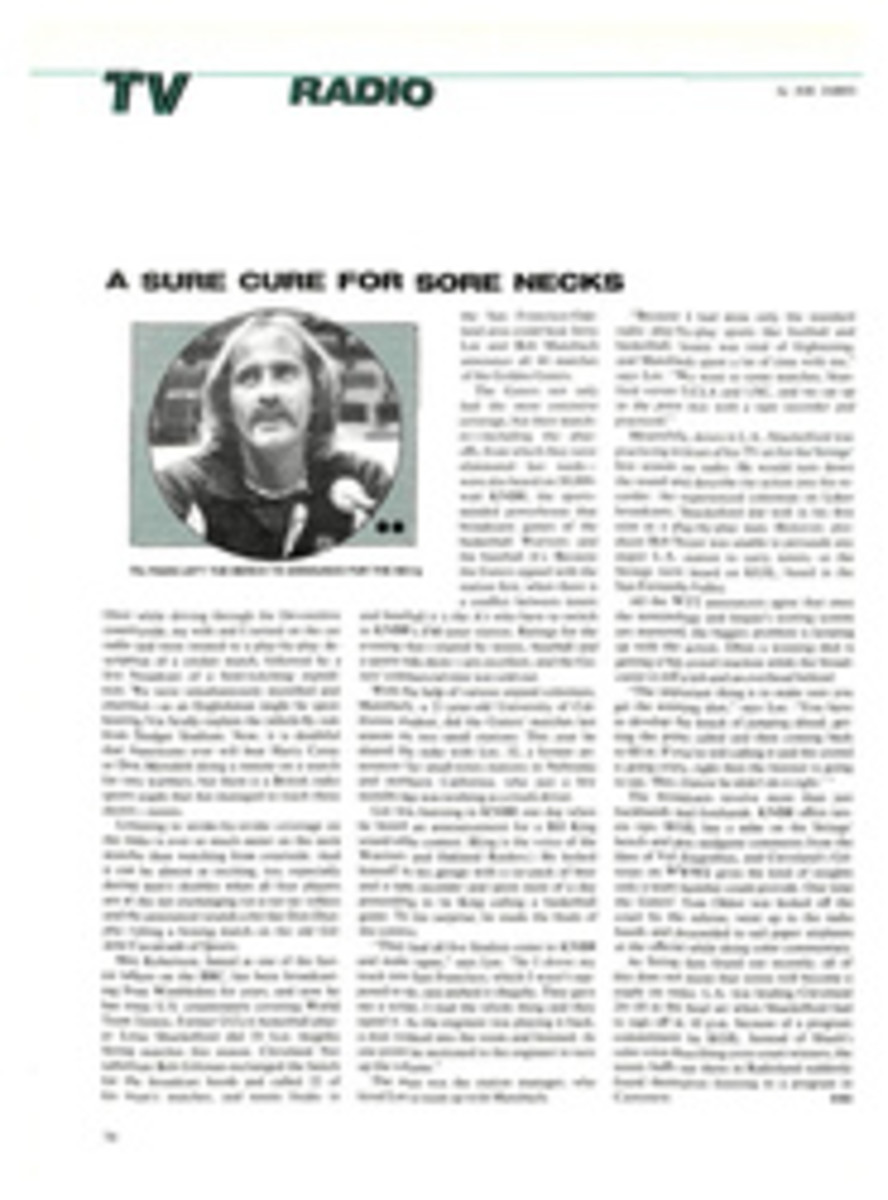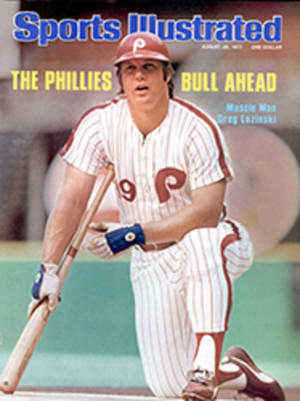
A SURE CURE FOR SORE NECKS
Once while driving through the Devonshire countryside, my wife and I turned on the car radio and were treated to a play-by-play description of a cricket match, followed by a live broadcast of a bird-watching expedition. We were simultaneously mystified and charmed—as an Englishman might be upon hearing Vin Scully explain the infield-fly rule from Dodger Stadium. Now, it is doubtful that Americans ever will hear Harry Caray or Don Meredith doing a remote on a search for rare warblers, but there is a British radio sports staple that has managed to reach these shores—tennis.
Listening to stroke-by-stroke coverage on the radio is ever so much easier on the neck muscles than watching from courtside. And it can be almost as exciting, too, especially during men's doubles when all four players are at the net exchanging rat-a-tat-tat volleys and the announcer sounds a bit like Don Dunphy calling a boxing match on the old Gillette Cavalcade of Sports.
Max Robertson, famed as one of the fastest talkers on the BBC, has been broadcasting from Wimbledon for years, and now he has some U.S. counterparts covering World Team Tennis. Former UCLA basketball player Lynn Shackelford did 35 Los Angeles String matches this season. Cleveland Net substitute Bob Giltinan exchanged the bench for the broadcast booth and called 22 of his team's matches, and tennis freaks in the San Francisco-Oakland area could hear Jerry Lee and Bob Mansbach announce all 44 matches of the Golden Gaters.
The Gaters not only had the most extensive coverage, but their matches—including the playoffs, from which they were eliminated last week—were also heard on 50,000-watt KNBR, the sports-minded powerhouse that broadcasts games of the basketball Warriors and the baseball A's. Because the Gaters signed with the station first, when there is a conflict between tennis and baseball it is the A's who have to switch to KNBR's FM sister station. Ratings for the evening slot—shared by tennis, baseball and a sports talk show—are excellent, and the Gaters' commercial time was sold out.
With the help of various unpaid colormen, Mansbach, a 21-year-old University of California student, did the Gaters' matches last season on two small stations. This year he shared the mike with Lee, 32, a former announcer for small-town stations in Nebraska and northern California, who just a few months ago was working as a truck driver.
Lee was listening to KNBR one day when he heard an announcement for a Bill King sound-alike contest. (King is the voice of the Warriors and Oakland Raiders.) He locked himself in his garage with a six-pack of beer and a tape recorder and spent most of a day pretending to be King calling a basketball game. To his surprise, he made the finals of the contest.
"They had all five finalists come to KNBR and make tapes," says Lee. "So I drove my truck into San Francisco, which I wasn't supposed to do, and parked it illegally. They gave me a script, I read the whole thing and they taped it. As the engineer was playing it back, a man walked into the room and listened. At one point he motioned to the engineer to turn up the volume."
The man was the station manager, who hired Lee to team up with Mansbach.
"Because I had done only the standard radio play-by-play sports like football and basketball, tennis was kind of frightening, and Mansbach spent a lot of time with me," says Lee. "We went to some matches, Stanford versus UCLA and USC, and we sat up in the press box with a tape recorder and practiced."
Meanwhile, down in L.A., Shackelford was practicing in front of his TV set for the Strings' first season on radio. He would turn down the sound and describe the action into his recorder. An experienced colorman on Laker broadcasts, Shackelford did well in his first stint as a play-by-play man. However, producer Bob Seizer was unable to persuade any major L.A. station to carry tennis, so the Strings were heard on KGIL, based in the San Fernando Valley.
All the WTT announcers agree that once the terminology and league's scoring system are mastered, the biggest problem is keeping up with the action. Often a winning shot is getting a big crowd reaction while the broadcaster is still a lob and an overhead behind.
"The important thing is to make sure you get the winning shot," says Lee. "You have to develop the knack of jumping ahead, getting the point called and then coming back to fill in. If you're still calling it and the crowd is going crazy, right then the listener is going to say, 'Hey, I know he didn't do it right.' "
The broadcasts involve more than just backhands and forehands. KNBR offers tennis tips, KGIL has a mike on the Strings' bench and gets midgame comments from the likes of Val Ziegenfuss, and Cleveland's Giltinan on WWWE gives the kind of insights only a team member could provide. One time the Gaters' Tom Okker was kicked off the court by the referee, went up to the radio booth and proceeded to sail paper airplanes at the official while doing color commentary.
As String fans found out recently, all of this does not mean that tennis will become a staple on radio. L.A. was leading Cleveland 24-18 in the final set when Shackelford had to sign off at 10 p.m. because of a program commitment by KGIL. Instead of Shack's calm voice describing cross-court winners, the tennis buffs out there in Radioland suddenly found themselves listening to a program in Cantonese.
PHOTO
GILTINAN LEFT THE BENCH TO ANNOUNCE FOR THE NETS

